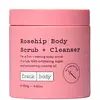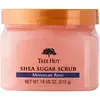What's inside
What's inside
 Key Ingredients
Key Ingredients

 Benefits
Benefits

 Concerns
Concerns

 Ingredients Side-by-side
Ingredients Side-by-side

Sucrose
HumectantGlycerin
HumectantSodium Cocoyl Isethionate
CleansingLavandula Angustifolia Oil
MaskingButyrospermum Parkii Butter
Skin ConditioningCocos Nucifera Oil
MaskingHelianthus Annuus Seed Oil
EmollientLimnanthes Alba Seed Oil
Skin ConditioningOenothera Biennis Oil
EmollientSimmondsia Chinensis Seed Oil
EmollientRosa Canina Fruit Oil
EmollientSodium Methyl Cocoyl Taurate
CleansingTocopheryl Acetate
AntioxidantMaltodextrin
AbsorbentWater
Skin ConditioningCoffea Arabica Seed Extract
MaskingLycium Barbarum Fruit Extract
AstringentRosmarinus Officinalis Leaf Extract
AntimicrobialAloe Barbadensis Leaf Juice
Skin ConditioningParfum
MaskingPhenoxyethanol
PreservativeSynthetic Fluorphlogopite
Silica
AbrasiveCI 77491
Cosmetic ColorantSucrose, Glycerin, Sodium Cocoyl Isethionate, Lavandula Angustifolia Oil, Butyrospermum Parkii Butter, Cocos Nucifera Oil, Helianthus Annuus Seed Oil, Limnanthes Alba Seed Oil, Oenothera Biennis Oil, Simmondsia Chinensis Seed Oil, Rosa Canina Fruit Oil, Sodium Methyl Cocoyl Taurate, Tocopheryl Acetate, Maltodextrin, Water, Coffea Arabica Seed Extract, Lycium Barbarum Fruit Extract, Rosmarinus Officinalis Leaf Extract, Aloe Barbadensis Leaf Juice, Parfum, Phenoxyethanol, Synthetic Fluorphlogopite, Silica, CI 77491
Sucrose
HumectantGlycerin
HumectantPolysorbate 20
EmulsifyingSilica
AbrasiveParfum
MaskingOenothera Biennis Oil
EmollientPersea Gratissima Oil
Skin ConditioningRosa Canina Fruit Oil
EmollientArgania Spinosa Kernel Oil
EmollientPrunus Amygdalus Dulcis Oil
Skin ConditioningButyrospermum Parkii Butter
Skin ConditioningCarthamus Tinctorius Seed Oil
MaskingCitrus Aurantium Dulcis Oil
MaskingMacadamia Ternifolia Seed Oil
EmollientRetinyl Palmitate
Skin ConditioningAscorbic Acid
AntioxidantPhenoxyethanol
PreservativeCaprylyl Glycol
EmollientSorbic Acid
PreservativeBlue 1 Lake
Cosmetic ColorantCI 14700
Cosmetic ColorantSucrose, Glycerin, Polysorbate 20, Silica, Parfum, Oenothera Biennis Oil, Persea Gratissima Oil, Rosa Canina Fruit Oil, Argania Spinosa Kernel Oil, Prunus Amygdalus Dulcis Oil, Butyrospermum Parkii Butter, Carthamus Tinctorius Seed Oil, Citrus Aurantium Dulcis Oil, Macadamia Ternifolia Seed Oil, Retinyl Palmitate, Ascorbic Acid, Phenoxyethanol, Caprylyl Glycol, Sorbic Acid, Blue 1 Lake, CI 14700
Ingredients Explained
These ingredients are found in both products.
Ingredients higher up in an ingredient list are typically present in a larger amount.
This ingredient is also known as shea butter. It is an effective skin hydrator and emollient.
Emollients help soothe and soften your skin. It does this by creating a protective film on your skin. This barrier helps trap moisture and keeps your skin hydrated. Emollients may be effective at treating dry or itchy skin.
Shea butter is rich in antioxidants. Antioxidants help fight free-radicals, or molecules that may harm the body. It is also full of fatty acids including stearic acid and linoleic acid. These acids help replenish the skin and keep skin moisturized.
While Shea Butter has an SPF rating of about 3-4, it is not a sunscreen replacement.
Shea butter may not be fungal acne safe. We recommend speaking with a professional if you have any concerns.
Learn more about Butyrospermum Parkii ButterGlycerin is already naturally found in your skin. It helps moisturize and protect your skin.
A study from 2016 found glycerin to be more effective as a humectant than AHAs and hyaluronic acid.
As a humectant, it helps the skin stay hydrated by pulling moisture to your skin. The low molecular weight of glycerin allows it to pull moisture into the deeper layers of your skin.
Hydrated skin improves your skin barrier; Your skin barrier helps protect against irritants and bacteria.
Glycerin has also been found to have antimicrobial and antiviral properties. Due to these properties, glycerin is often used in wound and burn treatments.
In cosmetics, glycerin is usually derived from plants such as soybean or palm. However, it can also be sourced from animals, such as tallow or animal fat.
This ingredient is organic, colorless, odorless, and non-toxic.
Glycerin is the name for this ingredient in American English. British English uses Glycerol/Glycerine.
Learn more about GlycerinOenothera Biennis Oil is the fixed oil derived from the seeds of the Evening Primrose.
Evening primrose oil is rich in fatty acids. These fatty acids include linoleic (60-85%), oleic (5-12%), palmitic (4-10%), and stearic (2-4%).
The fatty acid composition makes it a great ingredient for soothing and moisturizing skin. However, it may not be Malassezia folliculitis, or fungal acne safe.
Further research is needed on the role of evening primrose in treating eczema.
Evening primrose is native to North America.
Learn more about Oenothera Biennis OilParfum is a catch-all term for an ingredient or more that is used to give a scent to products.
Also called "fragrance", this ingredient can be a blend of hundreds of chemicals or plant oils. This means every product with "fragrance" or "parfum" in the ingredients list is a different mixture.
For instance, Habanolide is a proprietary trade name for a specific aroma chemical. When used as a fragrance ingredient in cosmetics, most aroma chemicals fall under the broad labeling category of “FRAGRANCE” or “PARFUM” according to EU and US regulations.
The term 'parfum' or 'fragrance' is not regulated in many countries. In many cases, it is up to the brand to define this term.
For instance, many brands choose to label themselves as "fragrance-free" because they are not using synthetic fragrances. However, their products may still contain ingredients such as essential oils that are considered a fragrance by INCI standards.
One example is Calendula flower extract. Calendula is an essential oil that still imparts a scent or 'fragrance'.
Depending on the blend, the ingredients in the mixture can cause allergies and sensitivities on the skin. Some ingredients that are known EU allergens include linalool and citronellol.
Parfum can also be used to mask or cover an unpleasant scent.
The bottom line is: not all fragrances/parfum/ingredients are created equally. If you are worried about fragrances, we recommend taking a closer look at an ingredient. And of course, we always recommend speaking with a professional.
Learn more about ParfumPhenoxyethanol is a preservative that has germicide, antimicrobial, and aromatic properties. Studies show that phenoxyethanol can prevent microbial growth. By itself, it has a scent that is similar to that of a rose.
It's often used in formulations along with Caprylyl Glycol to preserve the shelf life of products.
Rosehip Oil is a non-fragrant plant oil. Rosehips are a fruit from a rose bush and are edible. This oil has skin conditioning and hydrating properties.
Rosehip contains Vitamin C, Vitamin E, fatty acids and linolenic acids. These nourish your skin barrier. Having hydrated skin may help reduce the appearance of fine-lines and wrinkles.
Another great component of Rosehip Oil is Vitamin A, or retinol. Vitamin A encourages your skin to create more collagen.
Rosehip oil may help with reducing pigmentation. The lycopene and beta-carotene have skin-lightening properties. However, more studies are needed to confirm this.
Learn more about Rosa Canina Fruit OilSilica, also known as silicon dioxide, is a naturally occurring mineral. It is used as a fine, spherical, and porous powder in cosmetics.
Though it has exfoliant properties, the function of silica varies depending on the product.
The unique structure of silica enhances the spreadability and adds smoothness, making it a great texture enhancer.
It is also used as an active carrier, emulsifier, and mattifier due to its ability to absorb excess oil.
In some products, tiny microneedles called spicules are made from silica or hydrolyzed sponge. When you rub them in, they lightly polish away dead skin layers and enhance the penetration of active ingredients.
Learn more about SilicaSucrose is a natural sugar found in fruits, vegetables, and nuts. It is the main constituent of white sugar.
In skincare, sucrose is a humectant and can be a mild exfoliant.
Sucrose is hydrophilic, meaning it attracts water. This makes it an effective humectant and helps hydrate the skin.
Studies show sugars may worsen acne-prone skin due to it disrupting the skin's natural biome. We recommend speaking with a professional if you have any concerns.
In some products such as body scrubs, sucrose is used as an gentle exfoliant.
The term 'sucrose' comes from the french word for sugar, 'sucre'.
Learn more about Sucrose